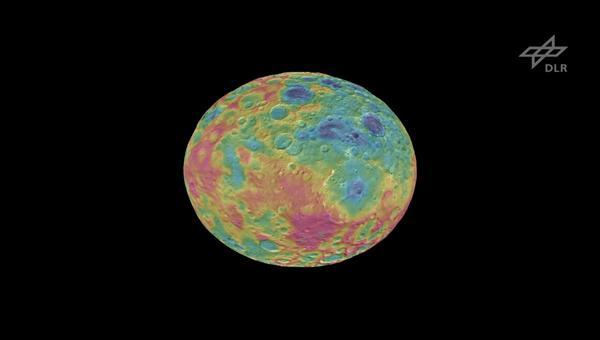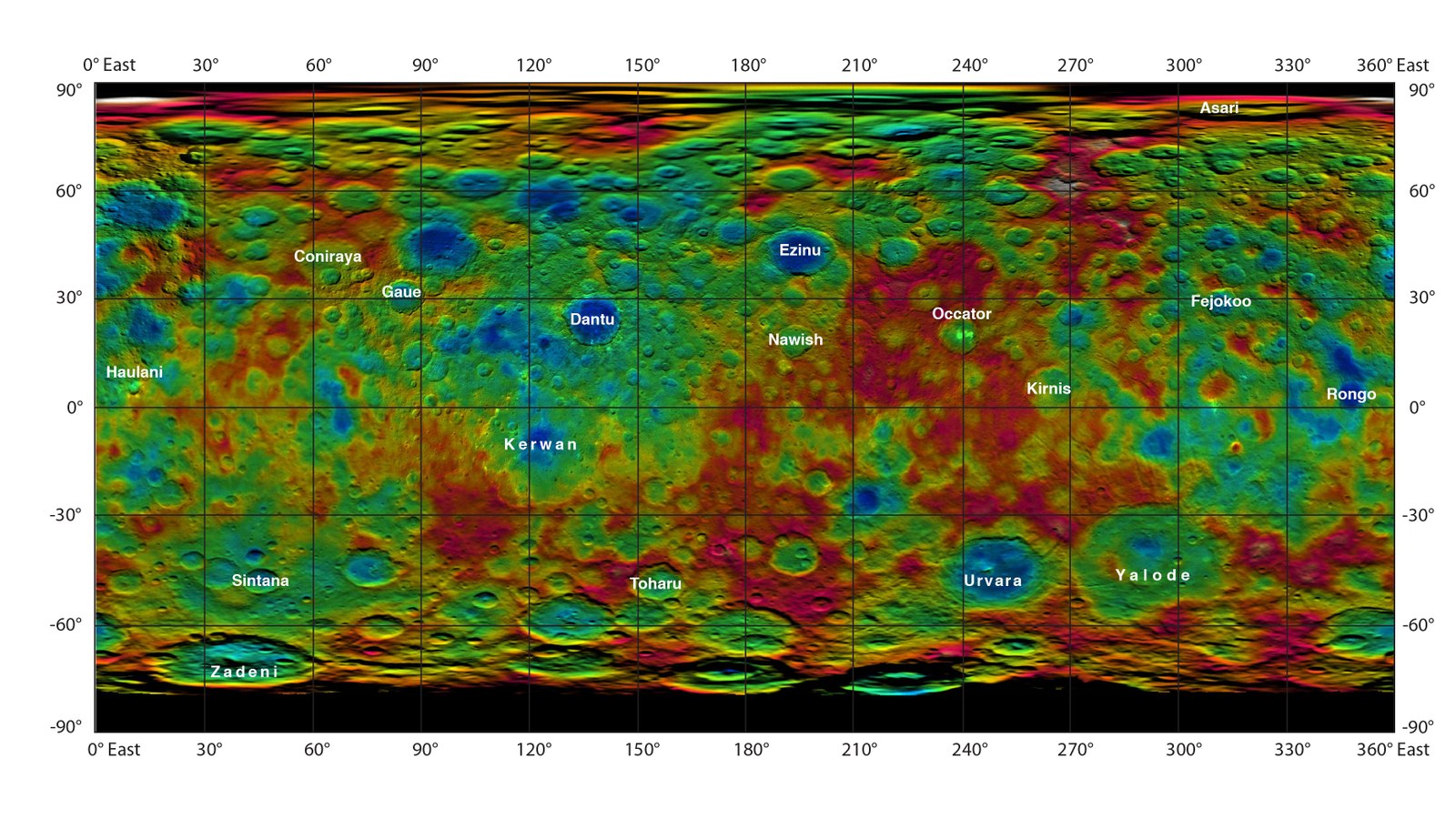Fertility deities on dwarf planet Ceres

Your consent to the storage of data ('cookies') is required for the playback of this video on Quickchannel.com. You can view and change your current data storage settings at any time under privacy.
NASA/JPL-Caltech/UCLA/MPS/DLR/IDA/PSI


Acting on behalf of the NASA Dawn mission team, researchers from the German Aerospace Center (Deutsches Zentrum für Luft- und Raumfahrt; DLR) chose 17 of approximately 150 fertility deities to name the most prominent craters on Ceres, which they presented to the International Astronomical Union (IAU). These names were chosen because the dwarf planet bears the name of the Roman goddess of agriculture. Now, deities from five continents – from Hawaii's Haulani and Occator, the Roman god of the harrow, to the German goddess Gaue – populate the dwarf planet's extremely varied surface. Tamayie, the Polynesian god of the coconut tree, and the Mexican deity Nanahuatl did not make the line-up. "The difference in elevation between the summit of the highest mountain and the base of the deepest crater is approximately 15 kilometres, which is roughly equivalent to the Earth's relief between Mariana Trench and Mount Everest," explains Ralf Jaumann, planetary researcher at DLR and member of the Dawn team. It is important to bear in mind, though, that the Earth is also 13 times larger than Ceres. "This kind of towering topography means that the processes playing out beneath Ceres' crust must be extraordinarily dynamic."
Craters – some deep, others shallow
The planetary researchers are particularly excited about the variance in crater depth in relation to the respective diameters: "The impact craters Dantu and Ezinu are extremely deep, while larger ones like Kerwan and Yalode are substantially flatter," says Jaumann. "This suggests that the ice gets increasingly mobile as the crater becomes larger and older, which means it will also lose depth." Dantu, named after a Ghanaian harvest god, possesses a diameter of roughly 120 kilometres and is five kilometres deep. Ezinu – a crater that takes its name from the Sumerian goddess of grain – is comparable in size. But this makes these two craters only half the size of the distinctly shallower Kerwan, named after a Hopi spirit of maize, and the crater Yalode, namesake of a West African Dahomey goddess. “The question is: how large must a crater be for the tension caused by impact in the crust to be sufficient for the movement of ice to even out the depression, hence precipitating elevation of the crater base and flattening of the crater edges – and how long does this process take?"
Naming the most prominent craters
Initially, only the most conspicuous, prominent craters were given names taken from the 17 fertility goddesses. This means that the 15 so-called quadrangles (sections) used to divide up the surface of Ceres were also named. DLR planetary researchers have produced geological maps for two of these regions – namely the areas around the Sintana crater and the Haulani crater – where several mysterious, white spots are visible. Haulani has a diameter of approximately 30 kilometres; measurements conducted using Dawn’s spectrometer have indicated that it is colder than the surrounding areas.
The most striking crater on Ceres was named after the Roman god Occator. The lightest patches – easily visible on the images of dwarf planet Ceres – are located inside the 90-kilometre diameter crater. At the centre of the 160-kilometre diameter Urvara crater, named after the Indo-Iranian goddess of plants and fields, is a prominent, three-metre hill. The crater that the Dawn team recently located on the dwarf planet’s Prime meridian was also given a name: Kait, after the Hittite goddess of grain.
Queueing up for the next crater
Deities that have not yet made the cut may still get their chance. "The other craters on Ceres will be named eventually," explains Thomas Roatsch from the DLR Institute of Planetary Research. "Roughly 75 craters on the Saturnian moon Enceladus have been named – and it is only half the size of dwarf planet Ceres." So the Dawn team will be faced with a creative challenge before all the important structures on Ceres have been named. The names must be pronounceable: “This is not easy when it comes to Polynesian deities, for example." And they must depict fertility culture across the world.
Flight to the next orbit
In the meantime, the Dawn spacecraft will continue to decrease its altitude, closing in on the surface of dwarf planet Ceres before it reaches the next orbit in August 2015. It will then gaze down on Ceres from an altitude of just 1470 kilometres – three times closer than during its most recent orbit. The Framing Camera on board the spacecraft will be unable to acquire any images during the flight, as Dawn's ion propulsion system will be in operation. Although Ceres is less than half the size of dwarf planet Pluto – imaged by the New Horizons orbiter during its flyby in July 2015 – its nearly 1000-kilometre diameter makes it the largest object in the asteroid belt between Mars and Jupiter.
The mission
The Dawn mission is managed by NASA's Jet Propulsion Laboratory (JPL) in Pasadena, which is a division of the California Institute of Technology, for NASA's Science Mission Directorate in Washington DC. The University of California, Los Angeles, is responsible for overall Dawn mission science. The camera system on the spacecraft was developed and built under the leadership of the Max Planck Institute for Solar System Research in Katlenburg-Lindau, Germany, with significant contributions from the German Aerospace Center (DLR) Institute of Planetary Research in Berlin and the Institute of Computer and Communication Network Engineering in Braunschweig. The Framing Camera project is funded by the Max Planck Society, DLR, and NASA/JPL.
